What We’re Reading: November 30th
Opinion: Limits to tree growth and longevity ($)
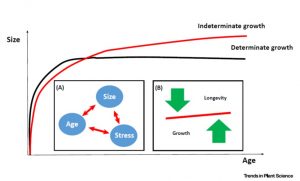 I think trees are awesome, and I mean that in the truest sense of the word. They dwarf us in height, and when we look at a tree that has lived for hundreds or thousands of years it is impossible not to think of that span in terms of human generations and human history. But, trees don’t live or grow forever. In this fascinating Opinion, Munné-Bosch explores why trees have limits (and at the same time, why these limits are comparatively so large). Distributed meristems decrease the accumulation of mutations at any one growing point, and secondary vascular tissues, stress resistance and resilience all contribute to the loveliness and awesomeness of trees. (Summary by Mary Williams) Trends Plant Sci. 10.1016/j.tplants.2018.08.001
I think trees are awesome, and I mean that in the truest sense of the word. They dwarf us in height, and when we look at a tree that has lived for hundreds or thousands of years it is impossible not to think of that span in terms of human generations and human history. But, trees don’t live or grow forever. In this fascinating Opinion, Munné-Bosch explores why trees have limits (and at the same time, why these limits are comparatively so large). Distributed meristems decrease the accumulation of mutations at any one growing point, and secondary vascular tissues, stress resistance and resilience all contribute to the loveliness and awesomeness of trees. (Summary by Mary Williams) Trends Plant Sci. 10.1016/j.tplants.2018.08.001
Opinion: Rapid responses to abiotic stress ($)
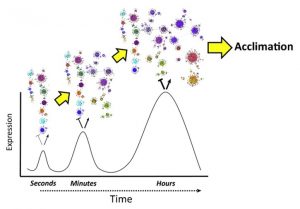 Several recent studies have demonstrated that plants are able to respond to environmental challenges within minutes, through electrical signals, calcium oscillations, hydraulic changes, metabolites such as glutamate, and reactive oxygen species. Kollist et al. review studies of rapid responses that control stomatal aperture as well those leading to systemic signalling and acclimation. Although transcriptomic studies for very early timepoints after stress are rare, there are intriguing reports of cyclic pulses in gene expression that might contribute to acclimation. As the authors observe, our understanding of these rapid responses is still quite limited, but have the potential to identify new tools and strategies for developing stress resilient plants. (Summary by Mary Williams) Trends Plant Sci. 10.1016/j.tplants.2018.10.003
Several recent studies have demonstrated that plants are able to respond to environmental challenges within minutes, through electrical signals, calcium oscillations, hydraulic changes, metabolites such as glutamate, and reactive oxygen species. Kollist et al. review studies of rapid responses that control stomatal aperture as well those leading to systemic signalling and acclimation. Although transcriptomic studies for very early timepoints after stress are rare, there are intriguing reports of cyclic pulses in gene expression that might contribute to acclimation. As the authors observe, our understanding of these rapid responses is still quite limited, but have the potential to identify new tools and strategies for developing stress resilient plants. (Summary by Mary Williams) Trends Plant Sci. 10.1016/j.tplants.2018.10.003
White Paper: Reinventing postgraduate training in the plant sciences
 What tools and skills do tomorrow’s plant scientists need, and how can we as a community ensure that today’s students get appropriate training? The Plant Science Research Network (PSRN), a consortium of plant science organizations and societies, has organized a series of workshops and discussions to try to answer these questions. Henkhaus et al. present key recommendations from these efforts, which include, “prioritization of and support for diversity, inclusion, and trainee well‐being; guidance and resources to define and pursue career objectives; flexible learning, unconstrained by institutional boundaries; disciplinary mastery achieved through research experiences; and community engagement through science communication.” (Summary by Mary Williams) Plant Direct J. 10.1002/pld3.95
What tools and skills do tomorrow’s plant scientists need, and how can we as a community ensure that today’s students get appropriate training? The Plant Science Research Network (PSRN), a consortium of plant science organizations and societies, has organized a series of workshops and discussions to try to answer these questions. Henkhaus et al. present key recommendations from these efforts, which include, “prioritization of and support for diversity, inclusion, and trainee well‐being; guidance and resources to define and pursue career objectives; flexible learning, unconstrained by institutional boundaries; disciplinary mastery achieved through research experiences; and community engagement through science communication.” (Summary by Mary Williams) Plant Direct J. 10.1002/pld3.95
Review. Protists: Puppetmasters of the rhizosphere microbiome ($)
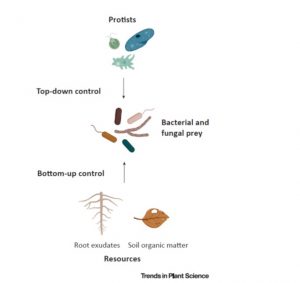 The enemy of my enemy is my friend, right? Gao et al. argue that we should be more aware of the beneficial impacts of friendly protists that eat potentially harmful microbes in the rhizosphere (they deliberately exclude plant pathogenic protists in their discussion). Protists are a diverse paraphyletic group of mostly single-celled eukaryotes. Bacterivorous protists contribute to nutrient cycling in the soil. They can also reduce the abundance of pathogenic microbes. Further research into the roles of diverse protists might enable them to be used as biostimulants to support plant growth. The authors conclude, “The time has come for protists to get out of their scientific niche and become the next biotechnological tool to engineer microbiomes to promote the functions that are needed to guarantee sustainable and resilient food production.” (Summary by Mary Williams) Trends Plant Sci. 10.1016/j.tplants.2018.10.011
The enemy of my enemy is my friend, right? Gao et al. argue that we should be more aware of the beneficial impacts of friendly protists that eat potentially harmful microbes in the rhizosphere (they deliberately exclude plant pathogenic protists in their discussion). Protists are a diverse paraphyletic group of mostly single-celled eukaryotes. Bacterivorous protists contribute to nutrient cycling in the soil. They can also reduce the abundance of pathogenic microbes. Further research into the roles of diverse protists might enable them to be used as biostimulants to support plant growth. The authors conclude, “The time has come for protists to get out of their scientific niche and become the next biotechnological tool to engineer microbiomes to promote the functions that are needed to guarantee sustainable and resilient food production.” (Summary by Mary Williams) Trends Plant Sci. 10.1016/j.tplants.2018.10.011
A synthetic oxygen sensing device for plants
 Plants can die from a lack of oxygen (hypoxia), which contributes to the devastating losses caused by flooding. Iacopino et al. set out to develop a more specific method for detecting oxygen levels in plants, based on the mammalian Hypoxia Inducible transcription Factor HIF. HIF is hydroxylated by an oxygen-dependent enzyme, with the hydroxylated form interacting specifically with another protein, pVHL. The authors designed and extensively optimized a system through which the oxygen-sensing domain of HIF mediates transcription of luciferase in an oxygen-sensitive manner. Their synthetic oxygen sensor is functional in Arabidopsis plants and causes no growth abnormalities, and it is more sensitive and more specific than a sensor based on the hypoxia-induced plant ADH gene. This system can next be exploited to improve crop survival in flood-prone areas. (Summary by Mary Williams) Plant Physiol. 10.1104/pp.18.01003
Plants can die from a lack of oxygen (hypoxia), which contributes to the devastating losses caused by flooding. Iacopino et al. set out to develop a more specific method for detecting oxygen levels in plants, based on the mammalian Hypoxia Inducible transcription Factor HIF. HIF is hydroxylated by an oxygen-dependent enzyme, with the hydroxylated form interacting specifically with another protein, pVHL. The authors designed and extensively optimized a system through which the oxygen-sensing domain of HIF mediates transcription of luciferase in an oxygen-sensitive manner. Their synthetic oxygen sensor is functional in Arabidopsis plants and causes no growth abnormalities, and it is more sensitive and more specific than a sensor based on the hypoxia-induced plant ADH gene. This system can next be exploited to improve crop survival in flood-prone areas. (Summary by Mary Williams) Plant Physiol. 10.1104/pp.18.01003
Importance of structural motifs of D3-D14 ubiquitin ligase in strigolactone signaling
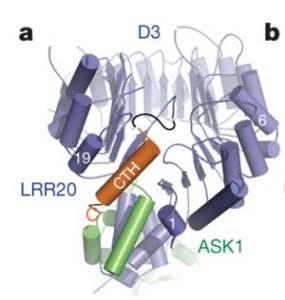 Strigalactones are phytohormones that regulate plant growth and development processes. The α/β hydrolase D14 (metabolizes strigolactone) interacts with the F-box protein D3 to ubiquitinate and degrade the transcription repressor D53. This process inhibits shoot branching. However, it is still unknown how D14 interacts with D3 to mediate hormone-dependent D53 ubiquitination. Shabek and colleagues show that the C-terminal α-helix of D3 can switch between two conformational states. One state facilitates the binding of D3 and D14 with a hydrolyzed strigolactone intermediate, while the other state recognized unmodified D14 and inhibits its enzymatic activity. This D3 motif enables D14 to recruit D53 in a strigolactone-dependent manner, which is part of the process that activates D14. This structural information helps to explain protein-based coordination between strigolactone signaling and metabolism. (Summary by Julia Miller) Nature 10.1038/s41586-018-0743-5
Strigalactones are phytohormones that regulate plant growth and development processes. The α/β hydrolase D14 (metabolizes strigolactone) interacts with the F-box protein D3 to ubiquitinate and degrade the transcription repressor D53. This process inhibits shoot branching. However, it is still unknown how D14 interacts with D3 to mediate hormone-dependent D53 ubiquitination. Shabek and colleagues show that the C-terminal α-helix of D3 can switch between two conformational states. One state facilitates the binding of D3 and D14 with a hydrolyzed strigolactone intermediate, while the other state recognized unmodified D14 and inhibits its enzymatic activity. This D3 motif enables D14 to recruit D53 in a strigolactone-dependent manner, which is part of the process that activates D14. This structural information helps to explain protein-based coordination between strigolactone signaling and metabolism. (Summary by Julia Miller) Nature 10.1038/s41586-018-0743-5
Reporter‐based forward genetic screen to identify bundle sheath anatomy mutants in A. thaliana ($)
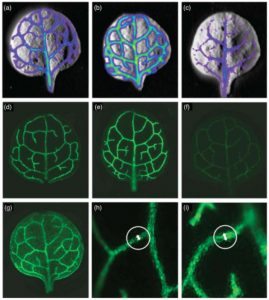 Installation of C4 photosynthesis into C3 crops appears a realistic way to boost crop yields. A key aspect of C4 photosynthesis is an enlarged bundle sheath volume and an increase in bundle sheath chloroplast number. To identify the regulators of this phenotype, Döring et al. subjected Arabidopsis seeds to EMS mutagenesis, and employed a high-throughput screen to identify plants with C4-like bundle sheath anatomy. The screen employed two independent reporter cassettes (luciferase and chloroplast-targetted GFP) to identify signal changes in bundle sheath cells or chloroplasts. Fifty-seven stable mutant lines were isolated, five of which showed an increase in bundle sheath cell number. A SHOREmap approach (mapping by sequencing) was used to identify a shortlist of candidate SNPs responsible for the phenotypes in each of these five mutant lines. Interestingly, these mutants were not only affected in bundle sheath anatomy, but also in the anatomy of their vascular tissue. This was probably due to a limitation of the GLDPA (P-subunit of glycine decarboxylase) promoter employed in the reporter cassettes used for screening, as it is active in both tissues – there are currently no known dicot promoters that exclusively drive expression in bundle sheath cells. No mutants with increased bundle sheath chloroplast number or size were isolated. (Summary by Mike Page) Plant J 10.1111/tpj.14165
Installation of C4 photosynthesis into C3 crops appears a realistic way to boost crop yields. A key aspect of C4 photosynthesis is an enlarged bundle sheath volume and an increase in bundle sheath chloroplast number. To identify the regulators of this phenotype, Döring et al. subjected Arabidopsis seeds to EMS mutagenesis, and employed a high-throughput screen to identify plants with C4-like bundle sheath anatomy. The screen employed two independent reporter cassettes (luciferase and chloroplast-targetted GFP) to identify signal changes in bundle sheath cells or chloroplasts. Fifty-seven stable mutant lines were isolated, five of which showed an increase in bundle sheath cell number. A SHOREmap approach (mapping by sequencing) was used to identify a shortlist of candidate SNPs responsible for the phenotypes in each of these five mutant lines. Interestingly, these mutants were not only affected in bundle sheath anatomy, but also in the anatomy of their vascular tissue. This was probably due to a limitation of the GLDPA (P-subunit of glycine decarboxylase) promoter employed in the reporter cassettes used for screening, as it is active in both tissues – there are currently no known dicot promoters that exclusively drive expression in bundle sheath cells. No mutants with increased bundle sheath chloroplast number or size were isolated. (Summary by Mike Page) Plant J 10.1111/tpj.14165
Quantitative imaging to investigate regulators of membrane trafficking in Arabidopsis stomatal closure
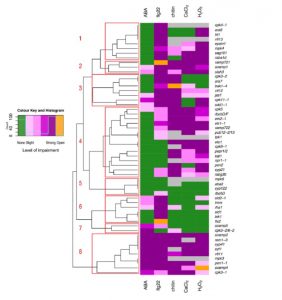 Properly functioning guard cells change size in response to myriad stimuli to control the passage of water and gasses through stomata. The change in volume is mirrored by changes in plasma membrane surface area, with membrane moving dynamically between tonoplast and plasma membrane as needed. Bourdais et al. have developed a high-throughput imaging method to quantify the dynamics of guard cells. They demonstrate its effectiveness by documenting the guard cell dynamics in several mutants previously shown to affect guard cells, including mutants affecting perception and signalling of ABA and pathogens, and those affecting membrane trafficking. Mutants can be clustered by how they respond to various stimuli. Interestingly, members of the same gene family cluster into different groups, indicating a diversification of function. (Summary by Mary Williams) Traffic 10.1111/tra.12625
Properly functioning guard cells change size in response to myriad stimuli to control the passage of water and gasses through stomata. The change in volume is mirrored by changes in plasma membrane surface area, with membrane moving dynamically between tonoplast and plasma membrane as needed. Bourdais et al. have developed a high-throughput imaging method to quantify the dynamics of guard cells. They demonstrate its effectiveness by documenting the guard cell dynamics in several mutants previously shown to affect guard cells, including mutants affecting perception and signalling of ABA and pathogens, and those affecting membrane trafficking. Mutants can be clustered by how they respond to various stimuli. Interestingly, members of the same gene family cluster into different groups, indicating a diversification of function. (Summary by Mary Williams) Traffic 10.1111/tra.12625
Symplastic coordination of root nodule development
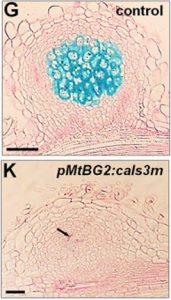 The establishment of root nodule symbiosis in legume roots involves the perception, infection, and accommodation of nitrogen-fixing rhizobia. The de novo formation of root nodules relies on complex developmental programs coordinated through different tissues via unknown cellular routes. Gaudioso-Pedraza et al. investigated the importance of plasmodesmatal cell-cell junctions (PD) for the initiation of root nodule development/symbiosis in the model legume Medicago truncatula. The authors identified a rhizobacteria-induced beta-1,3-glucanase (MtBG2) that is located at plasmodesmata, and whose upregulation coincides with a reduction in callose; a beta-1,3-glucan with known roles in plasmodesmatal regulation. MtBG2 overexpression promoted root nodule development and the cell-to-cell movement of soluble YFP from the epidermis to the cortex, supporting the idea that MtBG2 regulates plasmodesmatal conductance to promote signal movement and organogenesis in the cortex. Consistent with this idea, inducible expression of a hyperactive PD-occluding callose synthase variant (cals3m) driven by the MtBG2 promoter negatively impacted nodule development and the symbiotic accommodation of rhizobacteria. Collectively, these data identify plasmodesmata and MtBG2 as critical gatekeepers of signals that travel between cell layers to initiate root nodule organogenesis and symbiosis. (Summary by Phil Carella) Curr. Biol. 10.1016/j.cub.2018.09.031
The establishment of root nodule symbiosis in legume roots involves the perception, infection, and accommodation of nitrogen-fixing rhizobia. The de novo formation of root nodules relies on complex developmental programs coordinated through different tissues via unknown cellular routes. Gaudioso-Pedraza et al. investigated the importance of plasmodesmatal cell-cell junctions (PD) for the initiation of root nodule development/symbiosis in the model legume Medicago truncatula. The authors identified a rhizobacteria-induced beta-1,3-glucanase (MtBG2) that is located at plasmodesmata, and whose upregulation coincides with a reduction in callose; a beta-1,3-glucan with known roles in plasmodesmatal regulation. MtBG2 overexpression promoted root nodule development and the cell-to-cell movement of soluble YFP from the epidermis to the cortex, supporting the idea that MtBG2 regulates plasmodesmatal conductance to promote signal movement and organogenesis in the cortex. Consistent with this idea, inducible expression of a hyperactive PD-occluding callose synthase variant (cals3m) driven by the MtBG2 promoter negatively impacted nodule development and the symbiotic accommodation of rhizobacteria. Collectively, these data identify plasmodesmata and MtBG2 as critical gatekeepers of signals that travel between cell layers to initiate root nodule organogenesis and symbiosis. (Summary by Phil Carella) Curr. Biol. 10.1016/j.cub.2018.09.031
FACE facts hold for multiple generations; Evidence from natural CO2 springs
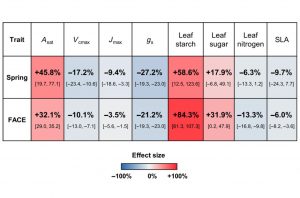 Assessing the effect of rising CO2 concentrations on plant growth and physiology traits is crucial in order to determine how ecosystems and crop production systems will perform in future climates. Such assessments have been made with free-air CO2 enrichment (FACE) experiments, which have provided a wealth of data on plant responses to changes in atmospheric CO2. However, it remains unclear how accurately data from single generation FACE studies predicts long-term adaptation to high CO2. Saban et al. obtained data for physiological parameters from published studies for plants surrounding natural CO2 springs, and performed a comprehensive meta-analysis. For plants near CO2 springs, eight of the nine traits assessed showed the same direction and an equivalent magnitude of change as plants from FACE experiments. This indicates that FACE experiments are capable of predicting long-term adaptation to high CO2 through the analysis of a single generation. The authors also discuss how plants near natural CO2 springs could be further studied to gain insight into the mechanisms of plant responses to high CO2. (Summary by Mike Page) Global Change Biol 10.1111/gcb.14437
Assessing the effect of rising CO2 concentrations on plant growth and physiology traits is crucial in order to determine how ecosystems and crop production systems will perform in future climates. Such assessments have been made with free-air CO2 enrichment (FACE) experiments, which have provided a wealth of data on plant responses to changes in atmospheric CO2. However, it remains unclear how accurately data from single generation FACE studies predicts long-term adaptation to high CO2. Saban et al. obtained data for physiological parameters from published studies for plants surrounding natural CO2 springs, and performed a comprehensive meta-analysis. For plants near CO2 springs, eight of the nine traits assessed showed the same direction and an equivalent magnitude of change as plants from FACE experiments. This indicates that FACE experiments are capable of predicting long-term adaptation to high CO2 through the analysis of a single generation. The authors also discuss how plants near natural CO2 springs could be further studied to gain insight into the mechanisms of plant responses to high CO2. (Summary by Mike Page) Global Change Biol 10.1111/gcb.14437
Increased temperatures may safeguard the nutritional quality of crops under future elevated CO2 concentrations
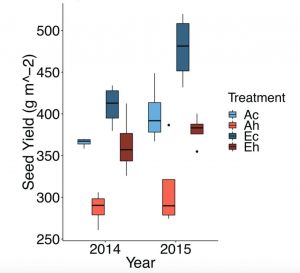 Increases in atmospheric CO2 have been shown to confer enhanced photosynthetic rates, boosting plant growth and yield. Unfortunately, there is evidence that the content of minerals important for human health are reduced in both the foliar and edible tissues when plants are grown under elevated CO2 (eCO2). However, future increases in atmospheric CO2 are likely to be combined with a concomitant increase in temperature. Köhler et al. explored the individual and combined effects of eCO2 and elevated temperature (eT) on the nutrient content of soybean. eCO2 increased yield and reduced the mineral content of soybeans, consistent with previous studies. In contrast, eT reduced soybean yield and increased the mineral content. When the treatments were combined, the effects of each individual treatment were largely cancelled out, suggesting that fears over future mineral nutrition may not be well-founded. It will be interesting to see if this response to both eCO2 and eT is conserved across other globally important crops. (Summary by Mike Page) Plant J 10.1111/tpj.14166
Increases in atmospheric CO2 have been shown to confer enhanced photosynthetic rates, boosting plant growth and yield. Unfortunately, there is evidence that the content of minerals important for human health are reduced in both the foliar and edible tissues when plants are grown under elevated CO2 (eCO2). However, future increases in atmospheric CO2 are likely to be combined with a concomitant increase in temperature. Köhler et al. explored the individual and combined effects of eCO2 and elevated temperature (eT) on the nutrient content of soybean. eCO2 increased yield and reduced the mineral content of soybeans, consistent with previous studies. In contrast, eT reduced soybean yield and increased the mineral content. When the treatments were combined, the effects of each individual treatment were largely cancelled out, suggesting that fears over future mineral nutrition may not be well-founded. It will be interesting to see if this response to both eCO2 and eT is conserved across other globally important crops. (Summary by Mike Page) Plant J 10.1111/tpj.14166



